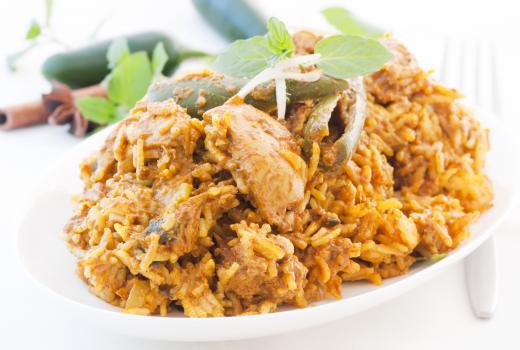Mixed rice is a dish consisting of rice and other foods, such as meats, vegetables, or beans. The combination of ingredients may provide enough nutrients to stand alone as a meal. As rice grows on every continent except Antarctica, some sort of mixed rice dish is a part of the cuisine of many cultures worldwide.
Many people think of mixed rice as a main course or appetizer, but it can form any part of a meal. Rice salad is often made of cold rice, vegetables, and a vinegar dressing. For dessert, rice puddings are dishes in which eggs, milk, and sometimes fruit are added to the rice. The rice for mixed rice dishes may be boiled in water, steamed over boiling water, baked in an oven, or cooked in water in a microwave.

Rice is the main agricultural crop of China, Southeast Asia, and India, and mixed rice is eaten frequently in these areas. One Chinese breakfast is a congee called juk in Mandarin. Bowls of hot rice are accompanied by side plates of pork, pickled vegetables, peanuts, scallions, oil, garlic, and chilies. India's most popular meal is rice and dal — beans, lentils, or peas — typically seasoned with chili powder, cumin, and curry. Northern Thai people eat rice with nam prik ong, a spicy pork and tomato sauce.

Perhaps the most famous European mixed rice dish is Spain's paella. Tradition holds that paella originated in the coastal city of Valencia, one Spain's rice-growing areas. The rice for paella is seasoned with saffron, and the toppings usually include shrimp or lobster, a Spanish sausage called chorizo, and peas. In Greece and the eastern Mediterranean, rice is often combined with raisins, onions and tomatoes and served cold and wrapped in grape leaves. This dish is known dolmades.

U.S. rice cultivation began in the 1600s in the coastal Carolinas, a humid, low-lying region in the eastern part of the country. A traditional mixed rice dish from the area, Hoppin' John, resembles West African rice meals and likely traces its roots to U.S. slaves. In addition to rice, the ingredients in Hoppin' John are ham hocks, black-eyed peas, onion, and hot chilies. People living in the Carolinas often eat Hoppin' John with collard greens on 1 January.

Just as mixed rice meals vary throughout the world, so do the types of rice used in it. The two main varieties are indica, or long-grain rice, and japonica, or short- to medium-grain rice. Indica rices get longer as they cook and are distinct grains when fully cooked; japonica rices grow wider, and the grains stick together when cooking is complete. Types of indica rice include basmati, grown mainly in Pakistan and India; Della, grown in the U.S.; and Taiwan's Taichung Sen No. 10. Arborio, grown in Italy and the U.S.; Camargue, from France’s Provence region; and rice for Japanese sushi are japonica rices.

The different rice varieties are all complex carbohydrates, which have health value as digestion aids and stabilizers of blood sugar. One cup (185 grams) of raw rice has about 13 to 15 grams of protein, though a cup of wild rice, a North American kind, has almost 24 grams. A cup of rice also has roughly 600 calories and no fat. Nutrients in rice include thiamin (vitamin B1), riboflavin (vitamin B2), niacin (vitamin B3) and iron. Rice has little of the essential amino acid lysine, but adding beans or peas, which are high in lysine, eliminates this nutrient gap.
